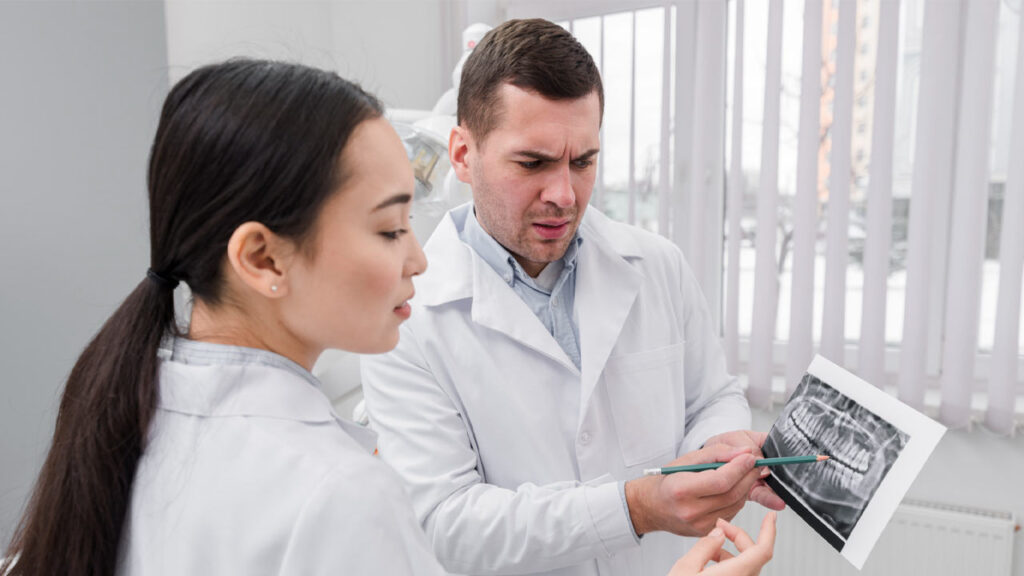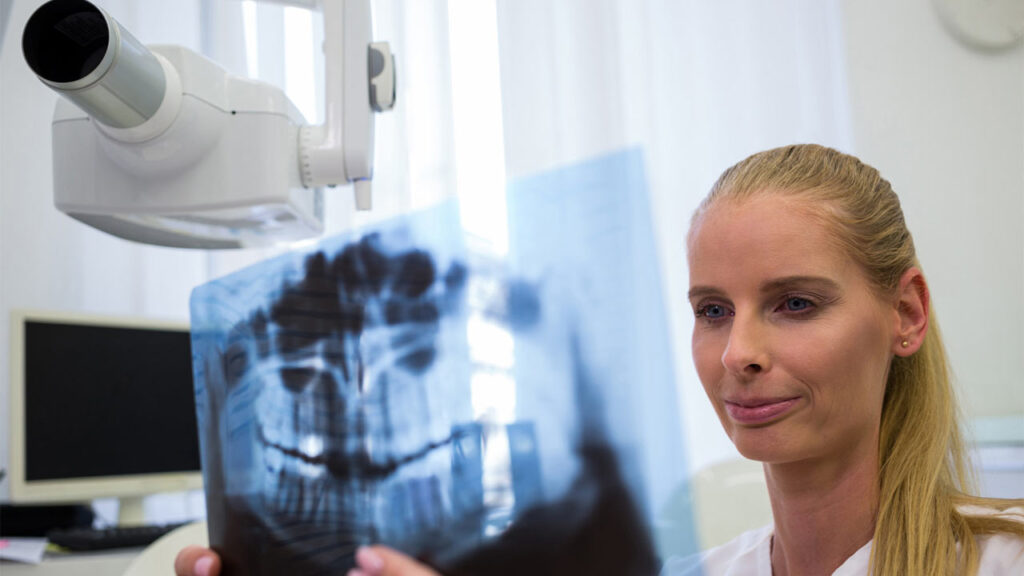Dental x-rays, also known as radiographs, are an important tool in maintaining oral health. They are used to capture detailed images of the teeth, jaws, and surrounding structures, providing valuable information that can aid in the diagnosis and treatment of dental issues. In this blog, we will discuss the benefits of dental x-rays for both the patient and the dentist, and the different types of x-rays available.
Explanation of what dental x-rays are and how they are used

Dental x-rays are non-invasive imaging tests that use a small amount of radiation to create detailed images of the teeth, jaws, and surrounding structures. These images can help dentists detect problems that may not be visible during a regular examination, such as cavities, tooth infections, and jaw problems. They can also aid in the planning and execution of treatment, such as orthodontics or dental implants.
Overview of the benefits of dental x-rays for both the patient and the dentist
Dental x-rays are beneficial for both the patient and the dentist. For the patient, they can help detect and prevent dental issues, leading to better oral health and potentially avoiding more invasive and costly treatment. For the dentist, x-rays provide [important information that can aid in the diagnosis and treatment of dental issues, leading to better outcomes for the patient.
Types of Dental X-Rays
Explanation of the different types of dental x-rays available
There are several types of dental x-rays available, each with its specific use and benefits. Some of the most common types include:
Bitewing x-rays: These x-rays capture images of the upper and lower teeth in one jaw, and are typically used to detect cavities between the teeth.
Panoramic x-rays: These x-rays capture a full image of the entire mouth, including the teeth, jaws, and surrounding structures. They are commonly used to assess the overall health of the jaws and teeth and to plan orthodontic or implant treatment.
Cephalometric x-rays: These x-rays capture images of the head, face, and jaw, and are typically used in orthodontic treatment planning to assess jaw growth and development.
Discussion of when each type of x-ray is typically used
The type of x-ray used will depend on the specific needs of the patient and the information the dentist is trying to gather. Bitewing x-rays are typically taken during regular check-ups to detect cavities between the teeth. Panoramic x-rays are taken when a dentist needs a full view of the mouth, such as when planning orthodontic or implant treatment. Cephalometric x-rays are used when assessing jaw growth and development in orthodontic treatment planning.
How Dental X-Rays Can Help with Diagnosis and Treatment
Discussion of how dental x-rays can be used to diagnose issues such as cavities, tooth infections, and jaw problems: –
Dental x-rays can be used to diagnose a variety of dental issues that may not be visible during a regular examination. For example, cavities between the teeth can be detected using bitewing x-rays, and panoramic x-rays can be used to assess the overall health of the jaws and teeth. Cephalometric x-rays can be used to assess jaw growth and development in orthodontic treatment planning.
Explanation of how dental x-rays can aid in the planning and execution of treatment, such as orthodontics or dental implants: –
Dental x-rays provide important information that can aid in the planning and execution of treatment. For example, panoramic x-rays can be used to determine the best location for dental implants and assess the overall health of the jaws and teeth before the procedure. Cephalometric x-rays can be used to assess jaw growth and development in orthodontic treatment planning, helping to create a customized treatment plan for each patient. This information can also aid in the monitoring of treatment progress, helping dentists to make any necessary adjustments to ensure the best possible outcome for the patient.
Safety and Risks of Dental X-Rays
Discussion of the safety precautions taken to minimize radiation exposure during dental x-rays: –
Dentists take several safety precautions to minimize radiation exposure during dental x-rays. This includes using lead aprons to protect the patient’s body, using the lowest possible radiation dose, and using digital x-rays instead of traditional film x-rays, which also reduces radiation exposure.
Explanation of the potential risks associated with dental x-rays and how they are managed: –
While radiation exposure from dental x-rays is considered safe, there is still a small risk of harm. The risk is considered small because the amount of radiation used is very low, and the benefits of dental x-rays far outweigh the risks. However, pregnant women and young children should avoid unnecessary dental x-rays, as their developing bodies may be more sensitive to radiation.
healthcareDental health is an important aspect of overall health and well-being. Take control of your dental health with our top-quality dental health care products. Say goodbye to painful and inconvenient dental issues and hello to a brighter, healthier smile.
These products are designed with the latest technology and are made from premium materials, ensuring that you get the best results. Whether you’re looking for a solution for sensitive teeth, gum health, or just want to keep your smile sparkling, our dental health care products have got you covered.
Tired of hiding your smile due to yellowing, stained, or sensitive teeth?
ProDentim is here to help. This advanced formula whitens and strengthens your teeth, while also reducing sensitivity and promoting oral health. Say goodbye to expensive and painful dental treatments, and start enjoying a bright, confident smile with ProDentim.
Click Here to Try ProDentim now and see the results for yourself!
Struggling with tooth sensitivity, gum problems or bad breath?
Dentitox Pro is the solution you need. This natural, effective formula helps to clean and strengthen your teeth and gums, giving you a brighter, healthier smile. Dentitox Pro is made with the finest ingredients and is free from harmful chemicals, making it safe and gentle for everyday use. Say goodbye to pain and embarrassment, and start enjoying a confident, beautiful smile with Dentitox Pro.
Click Here to Order now and get 20% off your first purchase!
Click Here for Professional Teeth Whitening
FAQ About the Importance of Dental X-Rays
Are dental x-rays safe?
Dental x-rays are considered safe, as the amount of radiation used is very low. Dentists take several safety precautions to minimize radiation exposure, and the benefits of dental x-rays far outweigh the risks.
How often should I have dental x-rays taken?
The frequency of dental x-rays will depend on your individual needs and oral health. Your dentist will recommend the appropriate frequency and types of x-rays for your individual needs.
Are there alternative options to dental x-rays?
There are alternative options to dental x-rays, such as 3D imaging and laser scanning, but they are not as widely available or as commonly used as traditional dental x-rays.
Can dental x-rays be used to detect oral cancer?
Dental x-rays are not typically used to detect oral cancer, as they do not provide detailed enough images of the soft tissues in the mouth. Other diagnostic tools, such as a visual examination, biopsy, and imaging tests, are used to detect oral cancer.
In conclusion, dental x-rays are an important tool in maintaining oral health. They provide valuable information that can aid in the diagnosis and treatment of dental issues and can help detect and prevent problems before they become more serious. Regular x-rays can lead to early detection and treatment of dental issues, resulting in better outcomes for the patient. Patients need to talk to their dentist about the appropriate frequency and types of x-rays for their individual needs. While there is a small risk associated with dental x-rays, the benefits far outweigh the risks, and dentists take several safety precautions to minimize radiation exposure.


1 thought on “The Importance of Dental X-Rays”